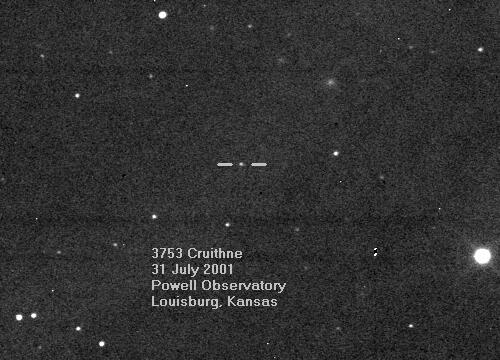Most people are familiar with Earth’s only natural satellite, the Moon. However, few are aware of a tiny, asteroid-like celestial body called 3753 Cruithne that follows a unique orbit around our planet.

Often referred to as Earth’s “second moon,” this fascinating object has intrigued scientists since its discovery in 1986. In this article, we will explore the characteristics of 3753 Cruithne, its relationship with Earth, and its significance for future research in astronomy.
Watch it as a video:
Table of Contents
Discovery and Characteristics of 3753 Cruithne
3753 Cruithne was discovered on October 10, 1986, by Scottish astronomer Duncan Waldron at the Royal Observatory in Edinburgh. The object is named after the Celtic people who inhabited ancient Britain (Cruithne is pronounced “croo-een-ya”). With an estimated diameter of 5 km, Cruithne is much smaller than Earth’s Moon, which has a diameter of 3,474 km.
The asteroid is classified as an Aten-type near-Earth asteroid, which means it has a semi-major axis smaller than Earth’s and a perihelion greater than 0.983 astronomical units (AU) from the Sun. Cruithne’s orbit is highly elliptical and inclined, taking it both inside and outside of Earth’s orbit around the Sun.

The Unique Orbit of 3753 Cruithne
The most intriguing aspect of 3753 Cruithne is its unusual orbital relationship with Earth. Instead of orbiting Earth directly like the Moon, Cruithne follows a complex horseshoe-shaped path around our planet. This peculiar orbit results from the combined gravitational forces of the Earth and the Sun.
Cruithne takes approximately 770 years to complete one cycle of its horseshoe-shaped orbit. During this time, it alternately comes closer to and moves farther away from Earth. At its closest, Cruithne is about 12 million miles (19 million km) away from our planet, while at its farthest, the distance increases to over 150 million miles (240 million km).
The ‘Second Moon’ Misconception
Unlike the Moon, Cruithne does not orbit Earth directly, and its relationship with our planet is more accurately described as an orbital resonance. This means that Cruithne and Earth share a synchronized dance around the Sun, where their respective gravitational forces influence each other’s orbits.
Scientific Significance and Future Research
The study of 3753 Cruithne offers valuable insights into the dynamics of celestial bodies in our solar system. Understanding the complex interactions between Earth, Cruithne, and the Sun can help researchers refine models of orbital mechanics and gravitational forces. Additionally, the study of near-Earth objects like Cruithne is crucial for assessing potential threats posed by asteroids and developing strategies for planetary defense.
Future research on 3753 Cruithne could involve sending a spacecraft to observe the object up close, similar to NASA’s OSIRIS-REx mission to the asteroid Bennu. Such a mission would provide invaluable data on the composition and structure of Cruithne, as well as its potential origins and geological history.
Conclusion
3753 Cruithne, Earth’s so-called “second moon,” is a fascinating celestial body with a unique orbital relationship to our planet. The study of Cruithne offers valuable insights into the dynamics of our solar system and can contribute to our understanding of near-Earth objects and potential threats from asteroids. As we continue to explore the mysteries of our cosmic neighborhood, objects like Cruithne remind us of the complex and ever-evolving dance of celestial bodies in the vast expanse of space.
Reference(s):

